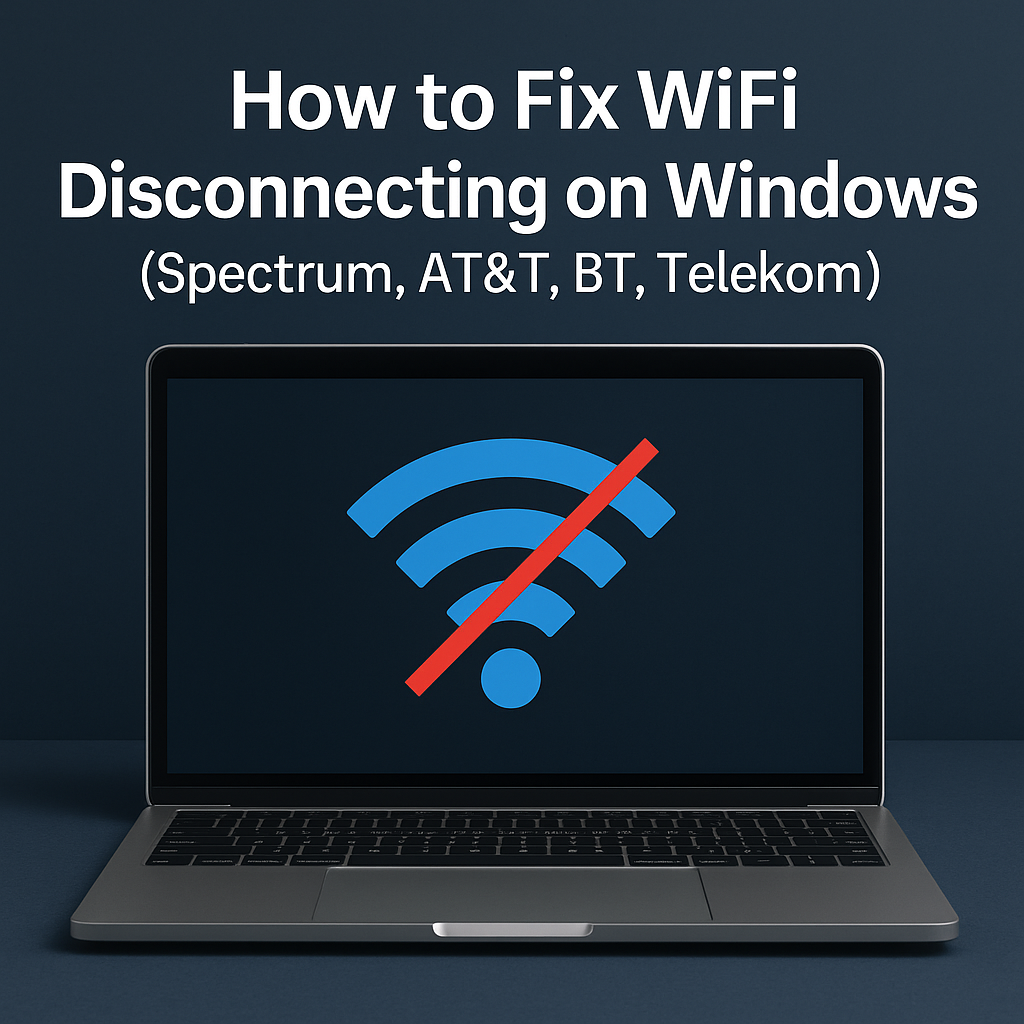How to Fix WiFi Disconnecting on Windows (Spectrum, AT&T, BT, Telekom)

There’s nothing more frustrating than a WiFi connection that keeps dropping—especially when you’re in the middle of a video call, streaming your favorite show, or working on an important project. Whether you use Spectrum, AT&T, BT, or Telekom, a frequently disconnecting WiFi can feel like a nightmare.
This issue is more common than you think. Many Windows users experience WiFi disconnecting problems due to simple settings misconfigurations, outdated drivers, or network glitches. The good news? You can fix most of these problems without calling your internet provider.
In this guide, we’ll cover the common causes, provide step-by-step fixes, share extra tips, and answer some of the most frequently asked questions to help you enjoy a stable and fast internet connection again.
Common Causes of WiFi Disconnecting on Windows
Here are the most common reasons why your WiFi disconnects frequently on Windows:
Outdated or corrupt WiFi drivers – If your drivers are not updated, Windows may struggle to maintain a stable connection.
Power management settings – Windows may disable your WiFi adapter to save power.
Router or modem issues – Problems with your Spectrum, AT&T, BT, or Telekom router can lead to frequent disconnects.
Network interference – Nearby devices or overlapping WiFi channels may cause instability.
Incorrect WiFi settings – Misconfigured IP, DNS, or adapter settings can break the connection.
Weak signal strength – Being too far from the router leads to drops.
Conflicts with VPN or firewall – Security tools may interrupt connectivity.
Step-by-Step Fixes for WiFi Disconnecting on Windows
Below are reliable methods to fix WiFi disconnecting issues across popular ISPs like Spectrum, AT&T, BT, and Telekom.
1. Restart Router and Laptop
Unplug your router and modem for 30 seconds.
Restart your laptop and reconnect.
This clears temporary network glitches.
2. Update WiFi Drivers
Press Windows + X and select Device Manager.
Expand Network Adapters.
Right-click your WiFi adapter and choose Update driver.
Select Search automatically for drivers.
Restart your laptop after updating.
3. Change Power Management Settings
Windows may disable your WiFi adapter to save energy. To fix this:
Open Device Manager → Network Adapters.
Right-click your WiFi adapter and select Properties.
Under Power Management, uncheck:
“Allow the computer to turn off this device to save power.”
4. Reset TCP/IP and Flush DNS
A corrupted network stack may cause disconnects. Run these commands in Command Prompt (Admin):
netsh int ip reset
ipconfig /release
ipconfig /renew
ipconfig /flushdns
Restart your computer and test your WiFi again.
5. Forget and Reconnect to Network
Go to Settings → Network & Internet → WiFi.
Select your WiFi network and click Forget.
Reconnect and enter your password again.
6. Adjust WiFi Adapter Properties
Open Device Manager → Network Adapters.
Right-click your adapter → Properties → Advanced tab.
Change settings like Preferred Band (try 5GHz if available).
Set Roaming Aggressiveness to “Medium-Low.”
7. Disable VPNs and Firewalls (Temporarily)
If you use a VPN or third-party firewall, disable them and test your WiFi connection. Sometimes, these interfere with ISP connections like AT&T or BT.
8. Run Windows Network Troubleshooter
Go to Settings → Update & Security → Troubleshoot → Additional troubleshooters.
Select Internet Connections and follow the prompts.
9. Update Router Firmware
Log into your router’s admin page (check the back of your Spectrum/AT&T/BT/Telekom router).
Look for Firmware Update.
Updating may fix disconnecting issues caused by outdated router software.
| Method | Difficulty | Works Best For | Time Required |
|---|---|---|---|
| Restart Router/Laptop | Easy | Temporary network glitches | 2–3 mins |
| Update WiFi Drivers | Easy | Driver-related issues | 5–10 mins |
| Change Power Settings | Easy | Power-saving disconnects | 3–5 mins |
| Reset TCP/IP & Flush DNS | Medium | IP/DNS misconfigurations | 5–8 mins |
| Forget & Reconnect Network | Easy | Wrong WiFi profiles | 2–3 mins |
| Adjust WiFi Adapter Properties | Medium | Weak/unstable signals | 5–7 mins |
| Disable VPN/Firewall | Easy | VPN conflicts | 1–2 mins |
| Update Router Firmware | Medium | Router-specific issues | 10–15 mins |
Extra Tips & Alternatives
Move closer to your WiFi router for a stronger signal.
Switch your router to a different WiFi channel to reduce interference.
Use an Ethernet cable for a stable connection if possible.
Upgrade your router if it’s more than 5 years old.
Contact Spectrum, AT&T, BT, or Telekom support if the problem persists—it may be on their end.
FAQs
Q1. Why does my WiFi keep disconnecting on Windows?
Most often due to outdated drivers, router issues, or power management settings.
Q2. Does changing DNS help fix WiFi disconnecting issues?
Yes. Switching to Google DNS (8.8.8.8) or Cloudflare DNS (1.1.1.1) can improve stability.
Q3. Why does my Spectrum WiFi disconnect frequently?
It could be interference, router problems, or ISP-side issues. Restarting your modem or updating firmware often helps.
Q4. Is 5GHz WiFi more stable than 2.4GHz?
Yes, 5GHz offers faster, more stable connections but shorter range.
Q5. Should I reset my router to fix WiFi disconnecting?
Yes, a full reset can resolve persistent issues—but back up your settings first.
Conclusion
A WiFi connection that keeps disconnecting on Windows can disrupt your daily workflow, but the fixes are often simple—whether it’s updating drivers, adjusting power settings, or resetting your network.
Try these solutions today, and if your WiFi still drops frequently with Spectrum, AT&T, BT, or Telekom, contact your ISP for support.
For more Windows troubleshooting guides, check out our related articles and keep your system updated for a smoother online experience.


2 Responses